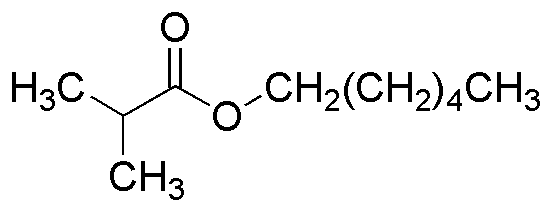Hexyl isobutyrate is widely utilized in research focused on:
- Fragrance Industry: This compound is commonly used as a fragrance ingredient in perfumes and personal care products, providing a pleasant, fruity aroma that enhances consumer appeal.
- Flavoring Agent: In the food industry, it serves as a flavoring agent, imparting a sweet, fruity taste to various food products, making it popular in confectionery and beverages.
- Solvent Applications: Hexyl isobutyrate acts as a solvent in paints, coatings, and adhesives, improving the application properties and drying times, which is crucial for manufacturers.
- Cosmetic Formulations: It is used in cosmetic products for its emollient properties, helping to improve skin feel and texture, making it a valuable ingredient in lotions and creams.
- Research and Development: In chemical research, it serves as a model compound for studying esterification reactions and can be used in the synthesis of other chemical compounds, aiding in the development of new materials.
General Information
Properties
Safety and Regulations
Applications
Hexyl isobutyrate is widely utilized in research focused on:
- Fragrance Industry: This compound is commonly used as a fragrance ingredient in perfumes and personal care products, providing a pleasant, fruity aroma that enhances consumer appeal.
- Flavoring Agent: In the food industry, it serves as a flavoring agent, imparting a sweet, fruity taste to various food products, making it popular in confectionery and beverages.
- Solvent Applications: Hexyl isobutyrate acts as a solvent in paints, coatings, and adhesives, improving the application properties and drying times, which is crucial for manufacturers.
- Cosmetic Formulations: It is used in cosmetic products for its emollient properties, helping to improve skin feel and texture, making it a valuable ingredient in lotions and creams.
- Research and Development: In chemical research, it serves as a model compound for studying esterification reactions and can be used in the synthesis of other chemical compounds, aiding in the development of new materials.
Documents
Safety Data Sheets (SDS)
The SDS provides comprehensive safety information on handling, storage, and disposal of the product.
Product Specification (PS)
The PS provides a comprehensive breakdown of the product’s properties, including chemical composition, physical state, purity, and storage requirements. It also details acceptable quality ranges and the product's intended applications.
Certificates of Analysis (COA)
Search for Certificates of Analysis (COA) by entering the products Lot Number. Lot and Batch Numbers can be found on a product’s label following the words ‘Lot’ or ‘Batch’.
*Catalog Number
*Lot Number
Certificates Of Origin (COO)
This COO confirms the country where the product was manufactured, and also details the materials and components used in it and whether it is derived from natural, synthetic, or other specific sources. This certificate may be required for customs, trade, and regulatory compliance.
*Catalog Number
*Lot Number
Safety Data Sheets (SDS)
The SDS provides comprehensive safety information on handling, storage, and disposal of the product.
DownloadProduct Specification (PS)
The PS provides a comprehensive breakdown of the product’s properties, including chemical composition, physical state, purity, and storage requirements. It also details acceptable quality ranges and the product's intended applications.
DownloadCertificates of Analysis (COA)
Search for Certificates of Analysis (COA) by entering the products Lot Number. Lot and Batch Numbers can be found on a product’s label following the words ‘Lot’ or ‘Batch’.
*Catalog Number
*Lot Number
Certificates Of Origin (COO)
This COO confirms the country where the product was manufactured, and also details the materials and components used in it and whether it is derived from natural, synthetic, or other specific sources. This certificate may be required for customs, trade, and regulatory compliance.

